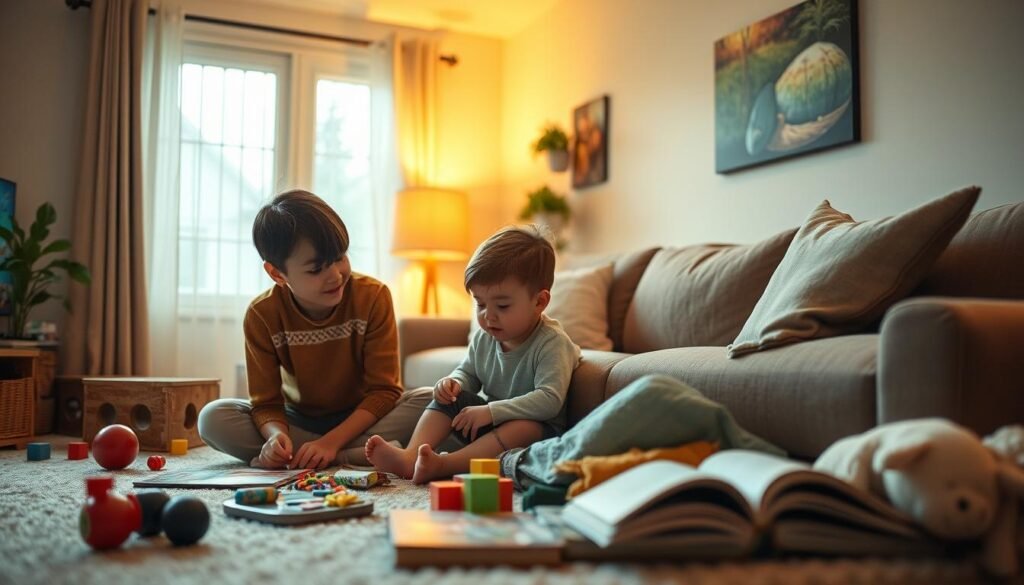Have you ever wondered about distal parenting and its benefits for your family? With more people working and learning from home, distal parenting is becoming common. It lets parents stay close to their kids even when they’re apart, which is key to distal parenting. Knowing about distal parenting helps you meet your family’s needs1.
Over 20 experts and organizations have worked on distal parenting. They’ve identified 35 roles related to kids and families. This shows distal parenting is a team effort1. It’s not just about being far apart. It’s about creating a caring space for your child to grow, which is vital for distal parenting.
Key Takeaways
- Distal parenting means parents are far from their kids but stay emotionally close, which is a key part of distal parenting.
- It offers parents more freedom and lets them teach their kids about healthy relationships and being independent.
- Learning about distal parenting helps you make better choices for your family and create a supportive environment for your child’s growth.
- With more people working and learning from home, distal parenting is becoming more common. It helps parents stay emotionally connected to their kids even when they’re apart.
- Distal parenting needs teamwork and effort but can be very rewarding and effective, as shown by its benefits.
- About 25 million children in the U.S. live without their biological father, showing the need for alternative parenting like distal parenting2.
What is Distal Parenting: Understanding the Modern Family Dynamic
Exploring distal parenting helps us see how it shapes family bonds. It’s about parents connecting with kids, even when they’re apart3. For example, using tech to keep in touch is a form of distal parenting4. This can positively or negatively affect kids, based on how much emotional support and communication they get3.
Think of families where parents work long hours or travel a lot. They use tech to stay close to their kids5. Video calls, messaging apps, and social media help them offer emotional support. But, it’s key to find a balance between work and family to ensure kids get the care they need4.
Studies reveal distal parenting’s big impact on kids’ emotional and psychological growth3. Kids with supportive and communicative parents, even from afar, tend to do better emotionally and socially5. But, kids without this support might face issues like anxiety and depression4.
In summary, distal parenting is a modern way of parenting that asks for creativity and flexibility. By using tech to stay connected, parents can offer emotional support and care, even when they’re not there3. As you dive deeper into distal parenting, you’ll discover its advantages and challenges. You’ll also learn how to make it work for your family4.
The Psychology Behind Successful Distance Parenting
Exploring distal parenting reveals the importance of emotional intelligence, communication, and trust. Distal parenting research shows these are key for a strong bond with your child, even from afar. Being mindful and present in your talks with your child can help develop these skills.
Key distal parenting characteristics include setting clear rules, having meaningful talks, and building strong bonds. This helps your child feel secure and stable, even when you’re not there. For example, a study showed that more physical contact with infants can lead to a 23% higher chance of secure attachment6.
Here are some tips to strengthen your bond with your child:
- Practice mindful parenting to increase emotional intelligence and resilience
- Establish clear boundaries and communicate effectively
- Make time for regular virtual interactions to stay connected
By using these tips and understanding the psychology of successful distance parenting, you can create a stronger bond with your child. Be flexible and adjust to your child’s changing needs as they grow7.
Remember, distal parenting is a journey, and it’s okay to make mistakes. The most important thing is to be patient, consistent, and committed to a loving relationship with your child8.
| Distal Parenting Characteristics | Importance |
|---|---|
| Emotional Intelligence | High |
| Communication | High |
| Trust | High |
Distal vs. Proximal Parenting: Breaking Down the Differences
Parenting styles come in two main types: distal and proximal. Knowing the difference can help you choose the best for your family. Distal parenting, common in modern cities, teaches kids to be independent. Proximal parenting, on the other hand, values closeness and emotional health.
Proximal parenting boosts emotional health. Studies show kids who get lots of physical touch do better in social skills and empathy9. Distal parenting, though, helps kids become more independent. This can make them more curious and engaged10.
Understanding the Benefits of Each Approach
Distal parenting lets kids explore and grow independent. This builds confidence and self-reliance10. Proximal parenting, by contrast, improves cognitive skills. It does this through better communication and language, which is key in the first three years9.
Finding a mix of both distal and proximal parenting is key. By knowing the good and bad of each, you can tailor a parenting style that fits your family.
Technology: Your Best Friend in Distal Parenting

Understanding the role of technology in distal parenting is key. What is distal parenting and how does tech help? It’s about using tech to keep in touch with kids, even when you’re far apart. This way, parents can stay involved and trust their kids, even from a distance.
About 70% of parents use social media to stay in touch with their kids11. This shows how tech helps parents and kids stay close, no matter where they are.
Technology makes it easier for parents to connect with their kids. Tools like video calls and messaging apps help keep the bond strong. Around 65% of parents text their teens to plan activities11.
Studies also show that 80% of teens use smartphones to talk to their parents11. This change shows how tech is changing how parents and kids communicate.
Using technology in distal parenting has many benefits. It helps parents stay in touch, monitor their kids, and offer emotional support. About 90% of parents feel tech helps them support their kids emotionally11.
For more on how technology helps in distal parenting, check outparenting resources. They can help you use tech to strengthen your bond with your child.
By using technology wisely, you can build a strong, supportive relationship with your child. Always remember to set boundaries, trust your child, and communicate openly11.
Creating Meaningful Connections Across the Miles
Being a distal parent comes with its own set of challenges. Yet, with a bit of creativity, you can make a strong bond with your child. Try setting up regular virtual time, like video calls or online game nights12. This keeps you connected and involved in your child’s life, even when you’re far apart.
Trust is key in distal parenting. Being consistent, reliable, and quick to respond to your child’s needs is essential13. This means setting clear rules and being open in your communication. It helps your child feel safe and supported, no matter the distance.
Keeping emotional closeness is also important. Share your thoughts, feelings, and daily experiences with your child12. Be open to theirs too. This way, you can feel close, even when you’re apart. You can share photos, videos, or stories about your day, and ask your child to do the same13.
The Unexpected Benefits of Distal Parenting
Exploring distal parenting reveals many benefits. It helps your child become independent and self-reliant14. By giving them space, they learn to solve problems and make decisions. This boosts their confidence and self-awareness15.
Distal parenting also promotes personal growth. Children learn to face challenges alone14. This makes them more resilient and adaptable. It also gives parents and children a sense of freedom to follow their interests15.
Some key benefits of distal parenting are:
- Increased independence and self-reliance
- Opportunities for personal growth and development
- A sense of freedom and autonomy for both parents and children
Adopting a distal parenting style equips your child for success. It’s not just about physical distance. It’s about creating a supportive environment for growth1415.
| Benefits of Distal Parenting | Description |
|---|---|
| Independence and Self-Reliance | Children develop essential life skills, such as problem-solving and decision-making |
| Personal Growth and Development | Children learn to navigate challenges on their own, leading to increased confidence and a stronger sense of self |
| Freedom and Autonomy | Both parents and children have the freedom to pursue their interests and passions |
Common Challenges and Smart Solutions
As you explore distal parenting, you’ll face many challenges. These can affect your bond with your child. It’s key to know these challenges and find good solutions16. One big problem is dealing with time zones. This makes it hard to keep in touch with your child regularly.
To solve this, use technology to talk and plan together. You can use video calls, messaging apps, or shared calendars. A study shows that using proven methods in new ways is key to success17.
Another hurdle is communication barriers. These can come from language, culture, or personal differences. To tackle this, listen well, be empathetic, and talk openly. This helps build trust and a strong bond, even when you’re apart. Here are some tips:
- Make regular calls to stay in touch and solve problems
- Use tech to talk and do things together
- Work on trust and closeness by being open and honest
By facing distal parenting challenges and finding smart ways to solve them, you can keep a strong bond with your child. Be ready to change and talk openly to make distal parenting work well16.
Remember, overcoming distal parenting challenges is a journey. Be patient, flexible, and supportive. This way, you can create a loving space for your child to grow, even from afar. And you’ll keep learning and growing in distal parenting17.
Age-Appropriate Strategies for Distance Parenting
Understanding your child’s needs at different ages is key in distal parenting. What is distal parenting and how does it affect raising your child from afar? It’s about changing your parenting style to fit your child’s age and needs. For babies, being sensitive and responsive is vital for their emotional, social, and cognitive growth18.
As kids get older, their needs change too. Parents must adjust their ways to keep a strong bond. This is important in distal parenting because it’s hard to balance discipline and emotional support.
A study shows that authoritative parenting leads to better outcomes for kids than authoritarian or permissive styles18. This is key in distal parenting because it helps maintain a balance. By knowing the distal parenting definition, parents can find effective ways to meet their child’s needs.
Research also highlights the importance of self-regulation skills for kids’ success in early adolescence19. Parents can help by creating a supportive environment that encourages independence and responsibility. On the other hand, less sensitive caregiving can lead to social and emotional problems later in life19. Emotional support and responsiveness are essential for kids to thrive.
In summary, distal parenting demands a deep understanding of your child’s needs. By tailoring your parenting to their age and stage, you offer the support and guidance they need to succeed. Whether dealing with the challenges of infancy or the complexities of adolescence, a thoughtful and responsive approach to distal parenting can be a game-changer20.
Building a Support System for Long-Distance Families
Being a long-distance parent can be tough. You might feel guilty, anxious, or disconnected from your child. But, with the right support, you can keep your bond strong and loving.
Start by finding a parenting community. This could be online or in-person. Connecting with others who face similar challenges can make you feel less alone. You can find these communities on social media or websites for long-distance parents21.
Also, include your extended family in your support network. This could be grandparents, aunts, uncles, and more. They can offer emotional support and help. Studies show that about 50% of caregivers are adult children, playing a big role in elder care, just like in long-distance parenting22.
Don’t forget to seek professional help. Look for therapists, counselors, or support groups for long-distance parents. They can offer guidance and emotional support. They can help you deal with challenges like co-parenting and communication23.
With a support system that includes a community, family, and professionals, you can face long-distance parenting challenges. You can keep your relationship with your child strong and loving, even with the distal parenting effects that come with it21.
Making the Most of In-Person Time

As a distal parent, it’s key to make the most of time with your child. This style helps kids grow independent and self-reliant24. Spend time doing things that help their brain grow, like reading and puzzles, which are great for distal parenting24.
Studies show that distal parenting focuses on brain development over physical touch. This can help kids become more independent24. Plan special activities, like outdoor games or creative projects, to make memories and spend quality time together.
Here are some tips for better quality time:
- Set aside time just for your child, without distractions
- Do activities that bring you closer, like hugs and stories
- Make sure to listen and talk openly with your child
By following these tips, you can strengthen your bond with your child. This is a big part of the benefits of distal parenting and the distal parenting style24.
Conclusion: Embracing Your Distal Parenting Journey
Starting your25 distal parenting journey means facing unique challenges and chances. The distance might seem like a hurdle, but the benefits are huge. With technology25, you can keep a strong connection with your kids, no matter where you are.
Distal parenting isn’t the same for everyone26. It needs you to be flexible and open to new ways of parenting25. Look for support from other parents online and in your area to help you through the good and tough times.
The secret to good distal parenting is to fully embrace it25. Stay connected and build a deep bond with your kids, even when you’re apart25. Start this journey with an open heart and a strong will to make a lasting bond with your children26. The benefits of distal parenting will make your family’s life richer than you thought possible.
FAQ
What is distal parenting?
What are the benefits of distal parenting?
How does distal parenting differ from proximal parenting?
What role does technology play in distal parenting?
How can parents create meaningful connections with their children in distal parenting?
What are the common challenges of distal parenting, and how can they be overcome?
How can parents ensure age-appropriate strategies for distance parenting?
Why is building a support system important for long-distance families?
Source Links
- PDF – https://familiasenpositivo.org/system/files/guia_de_buenas_practicas_ingles_v2.pdf
- Presence: The Essence of Parenting – Credo Magazine – https://credomag.com/2018/06/presence-the-essence-of-parenting/
- Developmental Trajectories and Antecedents of Distal Parental Supervision – https://pmc.ncbi.nlm.nih.gov/articles/PMC3740745/
- Distal and Proximal Family Contextual Effects on Adolescents’ Interparental Conflict Appraisals: A Daily Diary Study – https://pmc.ncbi.nlm.nih.gov/articles/PMC8719458/
- Japanese Parenting Style – And Differences from the West | O’Sullivan Counseling – https://socialanxietycounseling.com/japanese-parenting-style/
- Caregiver–child proximity as a dimension of early experience | Development and Psychopathology | Cambridge Core – https://www.cambridge.org/core/journals/development-and-psychopathology/article/caregiverchild-proximity-as-a-dimension-of-early-experience/AA3459015E15DF5B733445837E658A1B
- Parenting and teaching styles in relation to student characteristics and self-regulated learning – European Journal of Psychology of Education – https://link.springer.com/article/10.1007/s10212-023-00742-0
- Parental Availability as a Predictor of Academic Success among Students of a Private Residential School – https://digitalcommons.pcom.edu/cgi/viewcontent.cgi?article=1489&context=psychology_dissertations
- Proximal Parenting in Early Childhood Development – https://wheremotherhoodmatters.com/proximal-parenting/
- Distal and Proximal Parenting: Understanding the Difference | WonderBaby.org – https://www.wonderbaby.org/articles/distal-parenting
- A hands-on mother in a digital age – https://www.mprnews.org/story/2010/05/09/wills
- The relationship between parenting dimensions and adult achievement: evidence from the Whitehall II Study – https://pmc.ncbi.nlm.nih.gov/articles/PMC4921127/
- Parenting Styles in Emerging Adulthood – https://www.mdpi.com/2673-995X/4/2/35
- Parenting Styles, Family Characteristics, and Teacher-Reported Behavioral Outcomes in Kindergarten – https://pmc.ncbi.nlm.nih.gov/articles/PMC9937526/
- Parental perceived control and social support: Linkages to change in parenting behaviors during early adolescence – https://pmc.ncbi.nlm.nih.gov/articles/PMC5677566/
- The ParentingWell Practice Approach: Adaptation of Let’s Talk About Children for Parents With Mental Illness in Adult Mental Health Services in the United States – https://pmc.ncbi.nlm.nih.gov/articles/PMC9021592/
- Understanding parents’ sense-making of their role in adolescent daughters’ social media use through the lens of relational dialectics theory 2.0 – https://ir.library.illinoisstate.edu/cgi/viewcontent.cgi?article=1004&context=fpcom
- Distal and proximal parenting as alternative parenting strategies during infants’ early months of life: A cross-cultural study – https://www.academia.edu/2232704/Distal_and_proximal_parenting_as_alternative_parenting_strategies_during_infants_early_months_of_life_A_cross_cultural_study
- Parenting and Preschool Self-Regulation as Predictors of Social Emotional Competence in 1st Grade – https://pmc.ncbi.nlm.nih.gov/articles/PMC5015765/
- 4 Child Development and Early Learning | Transforming the Workforce for Children Birth Through Age 8: A Unifying Foundation – https://nap.nationalacademies.org/read/19401/chapter/8
- Long Distance Caregiving: A Systematic Review of the Literature – https://pmc.ncbi.nlm.nih.gov/articles/PMC5653258/
- Intergenerational Support, Cohesion, and Influence in Later Life: Evidence from the Longitudinal Study of Generations – https://www.ageing.ox.ac.uk/download/166
- A Longitudinal Mixed-Methods Characterization of Family Support from Adolescence to Young Adulthood in Autism and Other Developmental Disabilities – https://pmc.ncbi.nlm.nih.gov/articles/PMC11362242/
- What is Distal Parenting? – Grow Thoughtful – https://growthoughtful.com/what-is-distal-parenting/
- The ParentingWell Learning Collaborative Feasibility Study: Training Adult Mental Health Service Practitioners in a Family-Focused Practice Approach – https://pmc.ncbi.nlm.nih.gov/articles/PMC8019525/
- Direct and Indirect Effects of Parenting Style with Child Temperament, Parent-Child Relationship, and Family Functioning on Child Social Competence in the Chinese Culture: Testing the Latent Models – https://citeseerx.ist.psu.edu/document?repid=rep1&type=pdf&doi=cbe801a4ea9f2257868b4b27bb1c15bbce940fcd








0 responses to “Discover the Essentials of Distal Parenting”
Interesting read, but isnt distal parenting less effective in instilling discipline? How can you enforce rules from a distance?
Interesting read. But, isnt physical proximity crucial in initial years for a childs emotional development? How does distal parenting address this?
Distal parenting doesnt replace physical proximity, it complements it. Adaptability is key in modern parenting.
Distal parenting surely brings unique challenges. But dont you think it might foster independence in kids earlier than proximal parenting?